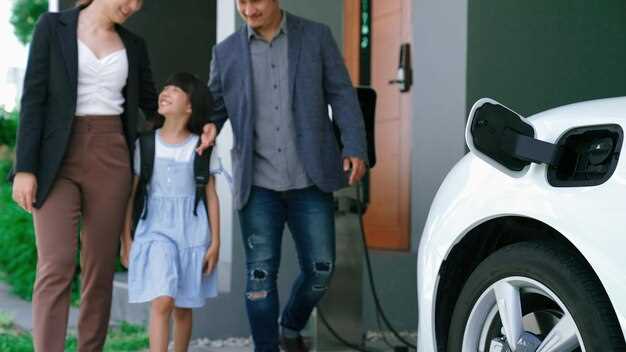Audi e-tron vs Q4 e-tron – Which EV Is Better?

The rise of electric vehicles (EVs) has revolutionized the automotive landscape, with renowned brands like Audi leading the charge. Among their electric offerings, the e-tron and Q4 e-tron stand out as two prominent players, each boasting unique features and capabilities. As consumers grow increasingly aware of the benefits and sustainability of electric transportation, the question arises: which of these electric models delivers better value for money?
Both the Audi e-tron and Q4 e-tron cater to different segments of the EV market. The conventional e-tron delivers a more luxurious experience with its spacious interior and high-end features, making it an appealing choice for those seeking comfort without compromising on performance. In contrast, the Q4 e-tron positions itself as a more accessible option, prioritizing efficiency and practicality for everyday use. This comparison will delve into key aspects such as performance, technology, and overall cost, allowing potential buyers to make an informed decision.
Ultimately, the choice between the Audi e-tron and Q4 e-tron hinges not only on personal preference but also on understanding which model aligns better with one’s lifestyle and budget. In the ensuing analysis, we will weigh the advantages and disadvantages of each electric vehicle to determine which option provides superior value in today’s competitive EV market.
Comparative Performance Metrics of Audi e-tron and Q4 e-tron
The Audi e-tron and Q4 e-tron represent two distinct approaches to the luxury electric SUV segment. Each model showcases unique performance characteristics that cater to different consumer needs.
The Audi e-tron, being the flagship SUV of the brand, is equipped with dual electric motors that deliver impressive power. With a total output of approximately 402 horsepower, the e-tron can accelerate from 0 to 60 mph in just about 5.5 seconds. This performance is complemented by a robust all-wheel-drive system that provides excellent traction and stability, making it ideal for various driving conditions.
In contrast, the Q4 e-tron is positioned as a more compact and affordable electric SUV. Its electric powertrain generates around 201 to 295 horsepower, depending on the variant. The Q4 e-tron reaches 60 mph in approximately 6.2 to 7.8 seconds, showcasing a competent performance for everyday driving. Its agility and lighter weight contribute to a dynamic driving experience, especially in urban settings.
Both models offer advanced battery technology, but the e-tron features a larger battery capacity, providing a longer range of up to 222 miles on a single charge. The Q4 e-tron, while having a smaller battery, still achieves a respectable range of about 250 miles, depending on the configuration you choose. This efficiency makes the Q4 e-tron appealing for short commutes and city driving.
In terms of charging capabilities, the e-tron supports fast charging up to 150 kW, allowing it to recharge quickly during long trips. Meanwhile, the Q4 e-tron also offers fast charging, although with a slightly lower capacity. Each SUV is compatible with various charging stations, ensuring convenience for electric vehicle owners.
In summary, while both the Audi e-tron and Q4 e-tron serve as excellent electric SUVs, the e-tron leans towards high-performance and luxury, whereas the Q4 e-tron emphasizes efficiency and value, making it a great option for budget-conscious buyers seeking an electric SUV experience.
Cost Analysis: Purchase Price and Incentives for Each Model
The Audi e-tron and Q4 e-tron are both compelling choices in the electric vehicle (EV) market, especially within the SUV segment. However, their price points and available incentives may influence potential buyers significantly. Understanding the cost structure of each model is crucial for making an informed decision.
The base model of the Audi e-tron typically starts at a higher price compared to the Q4 e-tron. This premium reflects Audi’s established luxury branding and the e-tron’s larger battery capacity and performance capabilities. Buyers can expect to invest more initially when opting for the e-tron, but many find the added features and driving experience to justify the expense.
On the other hand, the Q4 e-tron, being a more compact SUV, comes with a lower base price, making it an attractive option for those looking to enter the electric vehicle market without breaking the bank. The Q4 offers a range of configurations that can cater to different budgets, often resulting in a better value proposition for buyers who prioritize affordability over luxury.
Current incentives for electric vehicles also play a significant role in the overall cost analysis. In many regions, both the e-tron and Q4 e-tron qualify for federal tax credits, which can substantially lower the effective purchase price. These credits vary based on the model year, battery capacity, and state-specific incentives. It is essential for prospective buyers to check both federal and local incentives that may apply to their purchase. This can sometimes tip the balance in favor of one model over another.
In summary, while the Audi e-tron is positioned as a premium offering with higher upfront costs, it provides a luxury experience that many drivers seek. Conversely, the Q4 e-tron appeals to budget-conscious consumers looking for modern EV features at a more accessible price. Ultimately, the best value depends on individual preferences for luxury versus affordability, alongside the potential savings from incentives that can enhance the overall purchasing experience.
Charging Times and Battery Range: Real-World Usage Considerations

When evaluating electric SUVs like the Audi e-tron and Q4 e-tron, charging times and battery range are critical factors that significantly impact user experience. Both vehicles represent Audi’s commitment to the electric vehicle market, but they have different specifications that may meet varying needs.
The Audi e-tron features a larger battery capacity, which translates to a longer range compared to the Q4 e-tron. However, charging times also play an important role in how convenient these electric SUVs are for everyday use.
| Model | Battery Capacity (kWh) | Range (miles) | DC Fast Charge Time (80% in mins) |
|---|---|---|---|
| Audi e-tron | 95 | 222 | 30 |
| Q4 e-tron | 82 | 250 | 38 |
The e-tron provides an estimated range of 222 miles on a full charge, effectively covering most daily commutes. It supports rapid charging, allowing the battery to regain up to 80% capacity in just 30 minutes using a DC fast charger. Meanwhile, the Q4 e-tron boasts a slightly higher range of 250 miles due to its optimized energy management, but it requires 38 minutes to achieve 80% charge. This difference in charging time may influence users who prioritize quick turnaround times during long trips.
Real-world usage considerations also include charging infrastructure and home charging capabilities. Owners of both Audi models will find various public charging stations compatible with their vehicles, but the e-tron’s larger battery may necessitate more frequent charging depending on usage patterns. Alternatively, the Q4 e-tron may offer more flexibility for users who need longer range without as frequent stops.
Ultimately, the choice between the Audi e-tron and Q4 e-tron will depend on individual driving habits, preferences for charging times, and range requirements, highlighting the importance of understanding these specifications in real-world scenarios.
Interior Space and Usability: Comfort and Practicality for Families
When comparing the Audi e-tron and the Q4 e-tron, it’s essential to assess their interior space and usability for family needs. Both SUVs offer a blend of comfort, style, and practicality, but they cater to different preferences and priorities.
- Interior Space:
The Audi e-tron boasts a spacious interior, featuring generous legroom for both front and rear passengers. With a larger overall footprint, it provides ample headroom and cargo capacity, making it ideal for families with children and gear.
- Cargo Usability:
The e-tron offers a cargo space of around 29 cubic feet, expandable to 57 cubic feet with the rear seats folded down. The adjustable floor provides flexibility for loading items of various sizes, enhancing practicality for daily family activities.
- Comfort Features:
Both models come equipped with advanced climate control systems and high-quality seating materials. The e-tron emphasizes luxury with optional features like heated and ventilated seats, contributing to a comfortable journey for all family members.
- Child-Friendly Amenities:
Families will find that the e-tron includes child safety anchors and spacious rear seating, making it easier to install car seats. With high ride height, the entry and exit for little ones are less cumbersome compared to traditional sedans.
The Q4 e-tron, while slightly smaller, still provides notable usability for families:
- Interior Space:
The Q4 e-tron features a practical layout, with a comfortable cabin that can accommodate up to five passengers. Rear passengers enjoy sufficient legroom and headroom, although it may not match the e-tron’s expansive dimensions.
- Cargo Usability:
With about 24 cubic feet of cargo space available, the Q4 e-tron is suitable for everyday errands and family outings. Though smaller, its versatile design and hatchback-style opening facilitate easy loading and unloading.
- Comfort Features:
This model also focuses on providing a comfortable experience, featuring supportive seating and intuitive climate control options to maintain a pleasant environment for passengers.
- Child-Friendly Amenities:
Like the e-tron, the Q4 e-tron includes essential safety features for children, combined with easy access to rear seats, thus ensuring convenience for families on the go.
In summary, both the Audi e-tron and the Q4 e-tron present valuable options for families seeking an electric SUV. The e-tron excels in overall space and luxurious comfort, while the Q4 e-tron offers practicality without sacrificing essential features. Ultimately, the choice depends on family needs and lifestyle preferences.
Technology Features: Infotainment and Driver Assistance Comparison

The Audi e-tron and Q4 e-tron are electric SUVs that showcase advanced technology features, particularly in infotainment and driver assistance systems. Both models reflect Audi’s commitment to delivering a connected and safe driving experience, yet they have distinct offerings that cater to different needs and preferences.
Infotainment Systems
The Audi e-tron is equipped with a dual touchscreen MMI infotainment system that provides a seamless interface for navigation, music, and vehicle settings. The primary display is 10.1 inches, while the secondary screen, used for climate controls and other functions, measures 8.6 inches. This layout supports multi-tasking, allowing drivers to adjust settings without navigating away from the navigation screen.
Conversely, the Q4 e-tron features a slightly simplified version of the infotainment system, utilizing a single central display that is also 10.1 inches. While it may not offer the same versatility as the e-tron, it still delivers a user-friendly experience with vital information easily accessible. Both systems support wireless Apple CarPlay and Android Auto, increasing connectivity options for drivers.
Driver Assistance Technologies
When it comes to driver assistance, both the e-tron and Q4 e-tron are loaded with a comprehensive suite of features designed to enhance safety and convenience. The e-tron offers advanced systems such as adaptive cruise control, lane departure warning, and a 360-degree camera, providing an all-around view of the vehicle’s surroundings. Additionally, it includes the Traffic Jam Pilot feature, allowing for semi-autonomous driving under certain conditions.
The Q4 e-tron, while also offering adaptive cruise control and lane assist, takes a more cost-effective approach without some of the higher-end features found in the e-tron. It includes standard safety technologies like forward collision warning and automatic emergency braking, making it a strong contender in the compact electric SUV market.
Value Consideration
In terms of value, the choice between the Audi e-tron and Q4 e-tron may ultimately hinge on individual preferences for technology and features. The e-tron provides a high-tech experience with its superior infotainment system and advanced driver assistance capabilities, appealing to those who prioritize premium innovations. On the other hand, the Q4 e-tron offers a solid suite of essential features at a potentially lower price point, making it a practical choice for consumers seeking a reliable electric SUV with modern technology.
Long-Term Ownership Costs: Maintenance and Resale Value Insights
When considering electric SUVs like the Audi e-tron and Q4 e-tron, long-term ownership costs play a crucial role in determining overall value. Maintenance expenses for these vehicles generally lean towards being lower than their gasoline counterparts due to fewer moving parts and less frequent servicing needs. Electric powertrains require minimal maintenance, primarily focusing on battery checks and software updates, which can significantly reduce long-term costs.
The Audi e-tron, being a larger SUV, may have slightly higher maintenance costs compared to the Q4 e-tron. This is mainly due to its advanced features and potentially more expensive components, especially in the context of luxury vehicle repairs. Conversely, the Q4 e-tron, with its compact design and simplified technology, might provide a more budget-friendly maintenance experience over time.
Resale value is another critical factor when evaluating long-term ownership. Audi vehicles consistently perform well in retaining their value, and both the e-tron and Q4 e-tron are expected to follow this trend. However, the more established e-tron may have a slight edge in resale value due to its brand recognition and market presence compared to the newer Q4 e-tron. Buyers often seek reliable models with proven performance, which can bolster resale prospects.
In summary, while both electric SUVs present benefits in terms of maintenance and resale, the choice between the Audi e-tron and Q4 e-tron ultimately hinges on individual preferences for size, features, and long-term financial considerations. Understanding these ownership costs can significantly influence which model offers better value in the long run.




